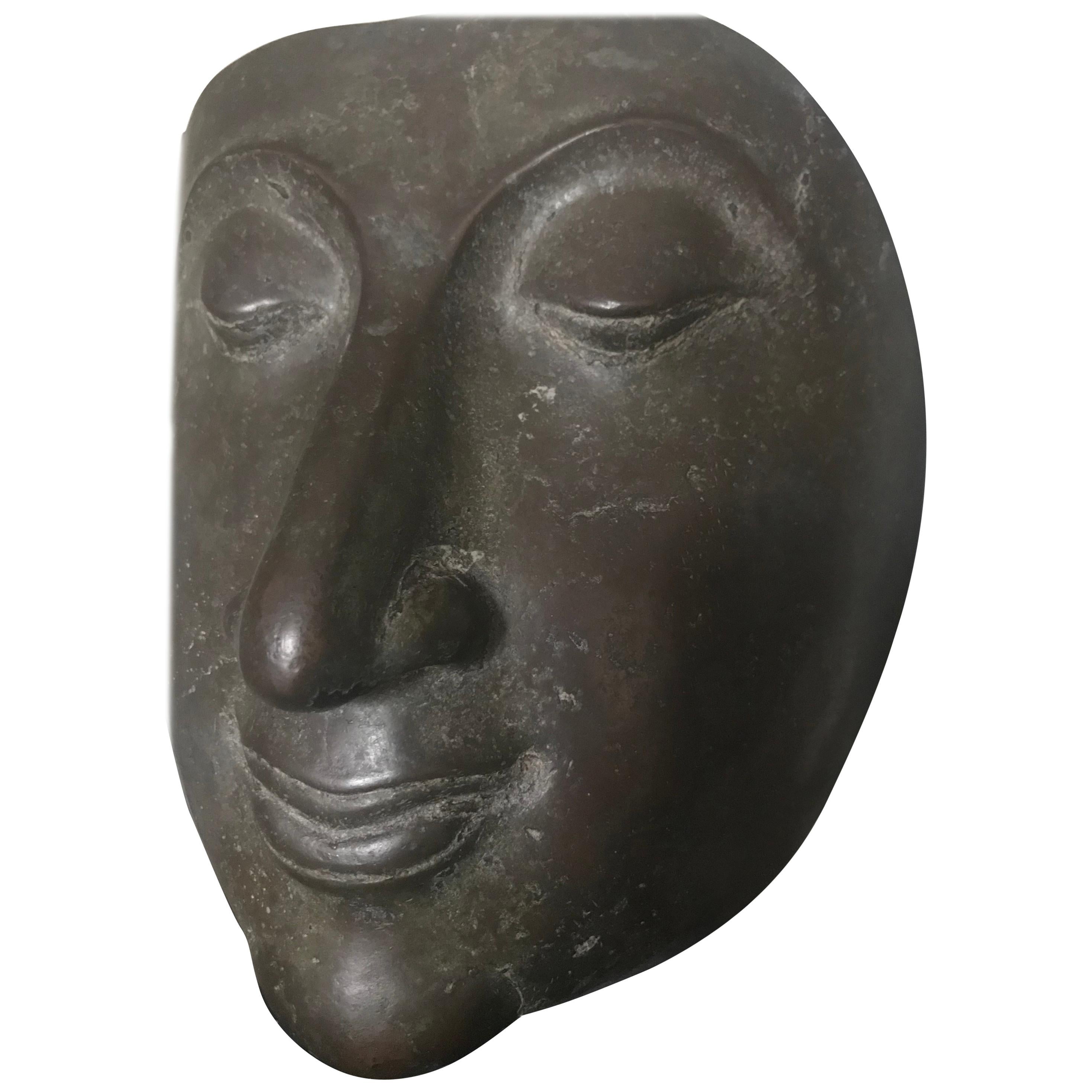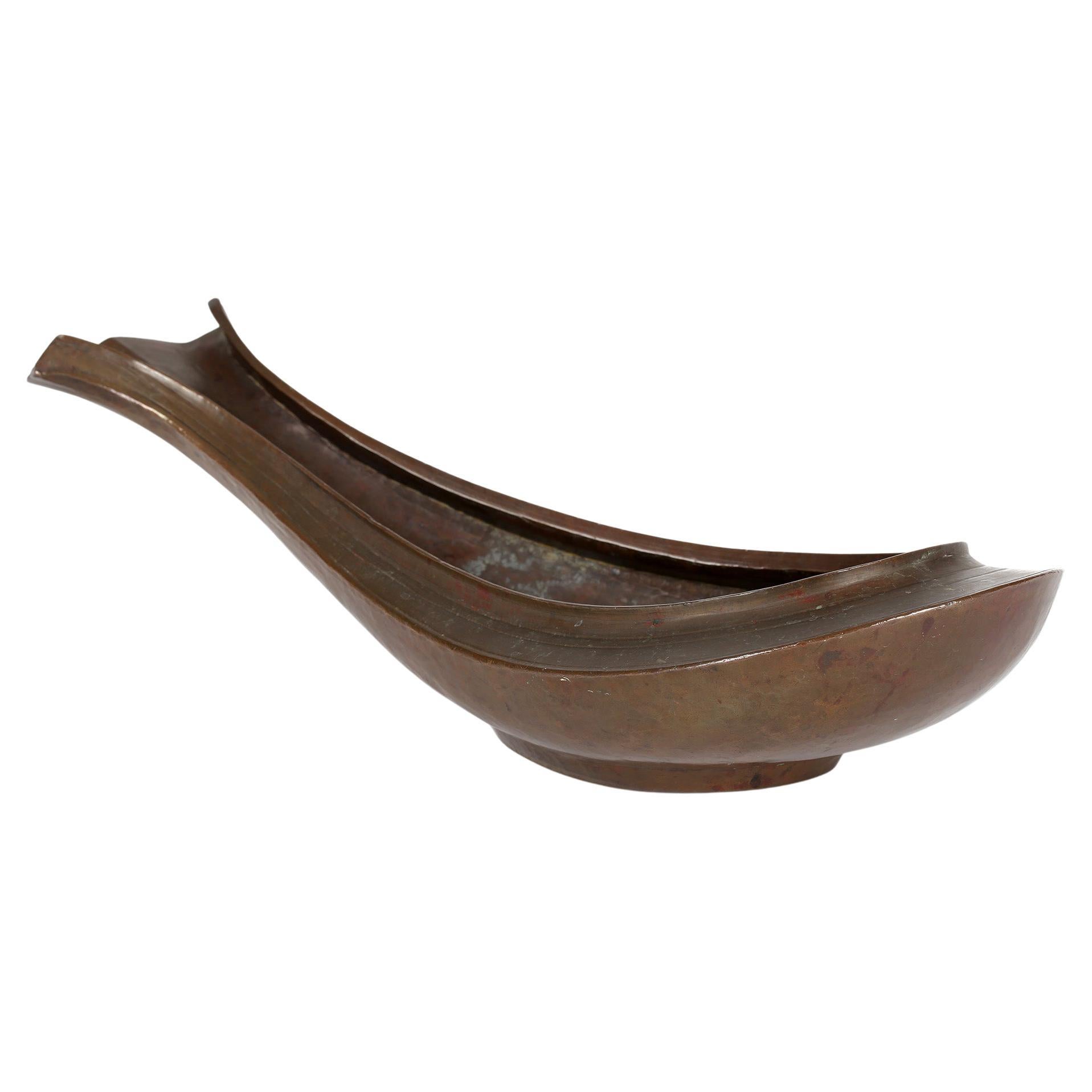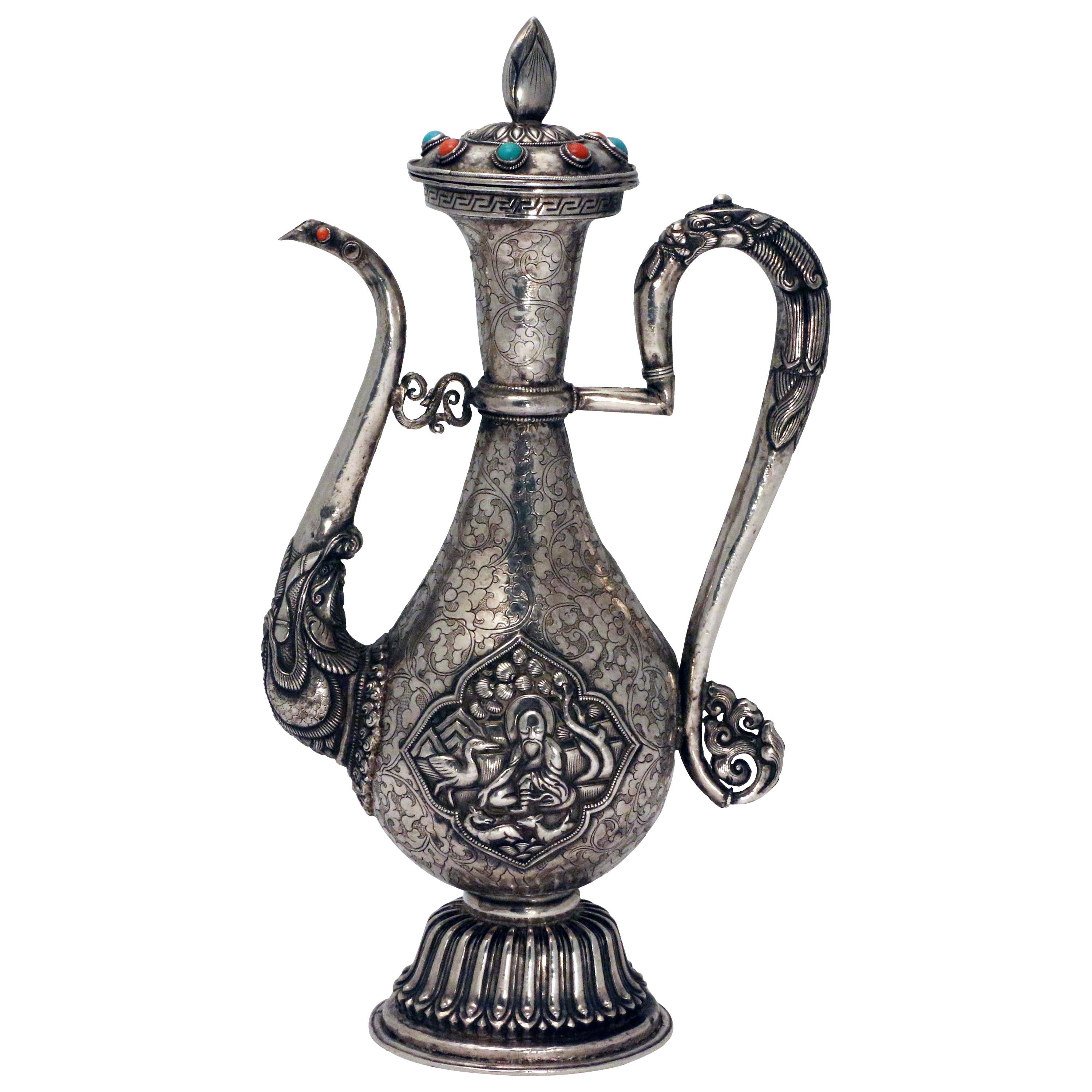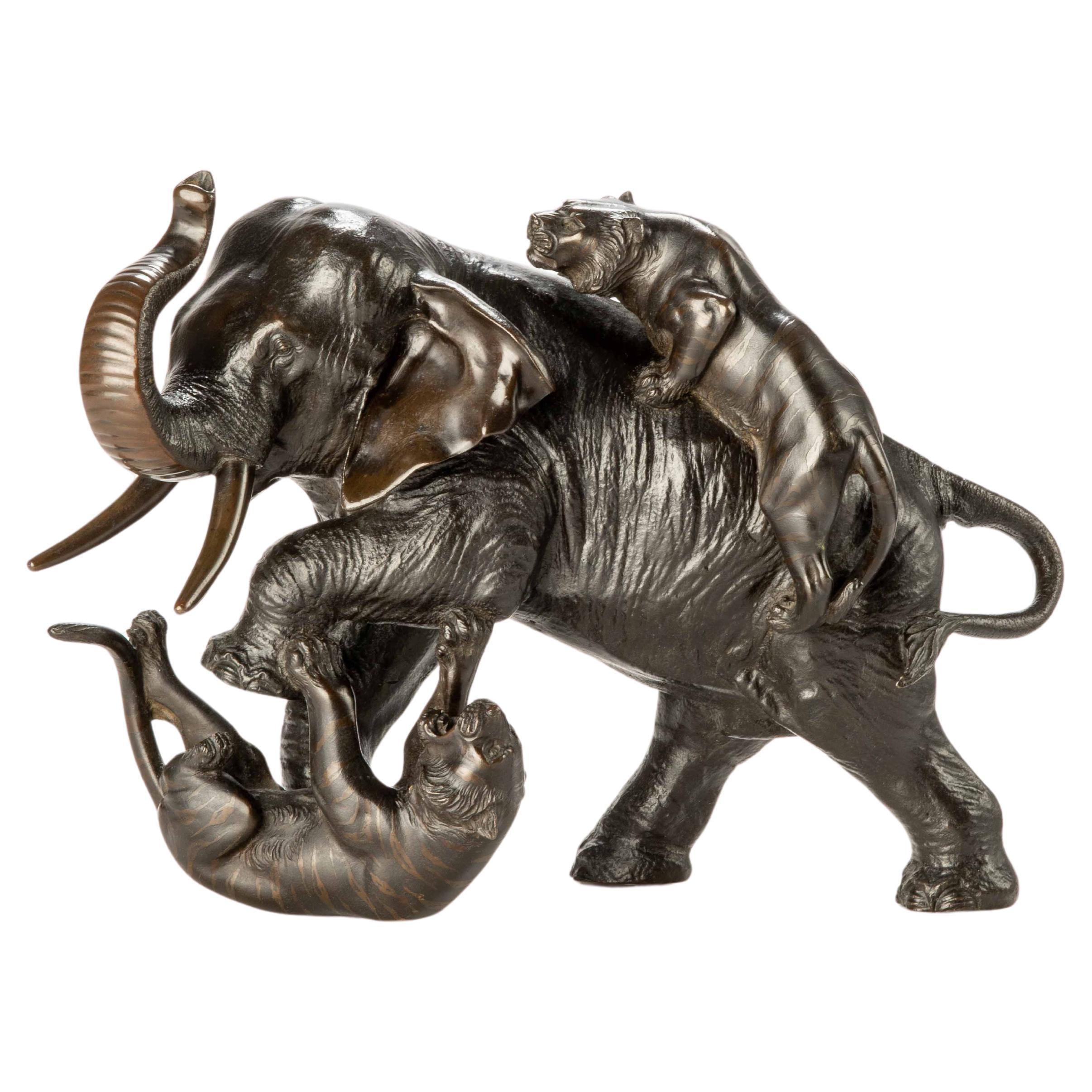Items Similar to An Indian part-gilt silver-clad ceremonial sceptre or mace with a tiger’s head
Want more images or videos?
Request additional images or videos from the seller
1 of 4
An Indian part-gilt silver-clad ceremonial sceptre or mace with a tiger’s head
About the Item
Northern India or Deccan, late 19th century
L. approx. 82 cm (excl. stand)
Provenance:
Private collection, United Kingdom
This remarkable gilt-silver soonta (ceremonial sceptre) also known as choba (ceremonial mace) with a tiger's head stands out as an unparalleled example. It has a wooden base, clad with thick sheet part-gilt silver and has fine details such as teeth and a curling tongue. Especially with the inlaid glass eyes, in combination with the grand sculptural design, it would have been integral to an Indian maharaja’s attire, known as lawajama in North India and biruthus in South India, as referenced by Jackson & Jaffer. They would symbolise authority, power, and sometimes an attribute of various deities, particularly those associated with strength or combat. For instance, the Hindu god Hanuman, known for his immense strength, is often depicted holding a mace (*chob* or gada in Sanskrit). Similarly, the god Vishnu and his avatar Krishna are also frequently depicted with a mace among their other attributes.
Courtiers would raise these sceptres wrapped in rich brocades, with the head visible, during processions, signalling their association with the monarch. Alongside fly-whisks and standards, they were indispensable in ceremonial parades, underscoring the ruler's prestige. Terlinden notes that a soonta berdar was tasked with carrying the sceptre. These individuals, proficient in courtly manners, played key roles during audiences, from managing entrances to introducing guests. Their esteemed position often earned them generous rewards, including land grants. See for a depiction of sceptres in use the top right of a painting in the collection of the V&A, titled Processional scene with Amar Singh, ruler of Thanjavur (Tanjore), and Sarabhoji, from circa 1797.
For a very comparable piece, but with an elephant’s head, see the collection of the Indian Museum, Kolkata. For other less similar examples, see the V&A Museum London.
Sources:
A. Jackson & A. Jaffer, Maharaja: The Splendour of India’s Royal Courts, London, V&A Publishing, 1999
Christiane Terlinden Serra, Mughal Silver Magnificence: 16th-19th century, Brussels, 1987, p. 64
- Dimensions:Height: 32.29 in (82 cm)Width: 9.85 in (25 cm)Depth: 13.78 in (35 cm)
- Materials and Techniques:
- Place of Origin:
- Period:
- Date of Manufacture:Circa 1850-1900
- Condition:Wear consistent with age and use.
- Seller Location:Amsterdam, NL
- Reference Number:1stDibs: LU5458237782132
About the Seller
5.0
Vetted Seller
These experienced sellers undergo a comprehensive evaluation by our team of in-house experts.
Established in 1985
1stDibs seller since 2020
19 sales on 1stDibs
Typical response time: 3 hours
- ShippingRetrieving quote...Ships From: Amsterdam, Netherlands
- Return PolicyA return for this item may be initiated within 7 days of delivery.
More From This SellerView All
- Fine Indian Silver Filigree Casket with Hinged Cover, 18th CenturyLocated in Amsterdam, NLA pair of very fine silver filigree rosewater sprinklers Possibly India, Karimnagar, early 18th century Measures: Height 31.6 cm and 31.7 cm,...Category
Antique 18th Century Indian Metalwork
MaterialsSilver
- Dutch Colonial Silver Dish with the Von Pfeffel Coat-of-arms, 17th CenturyLocated in Amsterdam, NLAn unusual Indonesian lobbed silver dish Jakarta (Batavia) or Coromandel coast, third quarter 17th century, apparently unmarked The eight lobbed dish exuberantly decorated with floral motifs, with the middle section replaced, consisting of indistinctly marked German silver from the early 19th century, bearing the coat-of-arms of the Von Pfeffel family. Diam. 30.5 cm Weight 461 grams Note: Lobbed silver dishes with exuberant floral decorations were characteristic of the decorative arts in the Netherlands in the first half of the 17th century. This style of floral decoration was adopted by silversmiths as well as by furniture makers working on the Coromandel Coast and in Batavia, often by workers who had fled the Coromandel Coast because of war and famine. In Batavia this style was known as “Custwerck” (work from the Bengal coast). These lobbed dishes are seldom marked. Only after 1667 the use of the town mark became obligatory in Batavia but only for silver made in Batavia not for silver imported in Batavia from other VOC settlements. The engraved coat of arms in the centre is a replacement of the original centre. The coat of arms can be identified as those of Christian Hubert von Pfeffel (1765- 1834). As a diplomat, statesman, ambassador of Bavaria in London and Saxony and councillor to the King of Bavaria, he was made “Freiherr” in 1828 and since then used this coat of arms. His son Karl Maximilian Friederich Hubert Freiherr von Pfeffel (1811-1890) in 1836 married Karoline Adelheid Pauline von Rottenburg (1805-1872), the natural daughter of Prins Paul von Württemberg (1785-1852) and his mistress Margrethe Porth. Paul was the jounger brother of the King Wilhelm I of Württemberg (1781-1864). The heraldic motto of the von Pfeffels Vur Schande habe den Huot means as much as “Beware of Shame”. Christian Hubert Theodoor Marie Karl von Pfeffel Karl Maximilian’s grandson was the last male in the von Pfeffel line. His daughter, Marie Louise (Paris in 1882 - Cornwall 1944), born and grown-up in France, changed her name in de Pfeffel. She was the great grandmother of Boris Alexander de Pfeffel Johnson, the present British Secretary of State. None of the members of the von Pfeffel family had any direct links with the Dutch East Indies but indirectly by way of the Royal House of Württemberg they did. Sophia Frederika Mathilda von Württemberg (1818-1877), daughter of Wilhelm I King of Württemberg, in 1839 married Willem III...Category
Antique Late 17th Century Indonesian Dutch Colonial Sterling Silver
MaterialsSilver
- Fabulous Indonesian Yogya-Silver PlateLocated in Amsterdam, NLAn Indonesian Yogya-silver plate Yogyakarta or Kotagede, 1935-1940, marked, (alloy) 800 and maker’s mark PH (Prawirohardjo, act. from 1935) Diam. 27.2 cm Weight 454 grams Th...Category
Early 20th Century Indonesian Art Deco Sterling Silver
MaterialsSilver
- Pair of Fine Islamic Silver Filigree Rosewater Sprinklers, Early 18th CenturyLocated in Amsterdam, NLA pair of very fine silver filigree rosewater sprinklers Possibly India, Karimnagar, early 18th century Height 31.6 cm and 31.7 cm, weight 39...Category
Antique Early 18th Century Indian Islamic Metalwork
MaterialsSilver
- Splendid and Heavy Late 17th Century Dutch-Colonial Silver Filigree SalverLocated in Amsterdam, NLA splendid and heavy Dutch-colonial silver filigree salver Indonesia, Batavia (Jakarta) or possibly Padang, West Sumatra, 2nd half 17th century Diam. 22.9 cm Weight 551 grams This filigree-work was probably done by Chinese masters...Category
Antique 17th Century Indonesian Dutch Colonial Metalwork
MaterialsSilver
- Rare Chinese Tonkin Ware Cup-and-Saucer, Early 18th CenturyLocated in Amsterdam, NLA Chinese made tonkin ware gilt- and lacquer cup and saucer China or Japan, Chinese artisans, early 18th century The black-lacquered cup with gilt handles in the shape of sculptured chrysanthemums and a lobbed edge decorated with gilt engraved border, with a gilt foot-ring that fits into the saucer ring, with two cartouches showing partly undercut gilt relief trees and birds on a gilt granulated background, black lacquered bracket-lobed edge, depicting gilt engraved peony scrolls and three cartouches decorated with high relief gilt trees and birds on a gilt granulated background, the centre with engraved chrysanthemum, enclosed by a raised ring upon which the cup fits, around which a circular panel decorated with high gilt relief trees, flowers, birds and a butterfly on a gilt granulated background. Measures: Cup: H. 5.7 x W. 8.5 cm Saucer: Diameter 13 cm Provenance: Collection Felix Schäfer Note: The decoration of the cup and saucer is identical to the slightly smaller cup and saucer...Category
Antique Early 18th Century Chinese Chinese Export Metalwork
MaterialsOther
You May Also Like
- Bronze Part of Buddha HeadLocated in Schellebelle, BEBronze part of Buddha head mounted on a stand, 15th century. Great patina. South East Asia.Category
Antique 15th Century and Earlier Southeast Asian Metalwork
MaterialsBronze
- South Indian Antique Metal Clad Wood Rice BucketLocated in Bishop's Stortford, HertfordshireA fine and unusual antique metal clad and mounted wooden rice or grain bucket with attached steel poker originating from Southern India. The twin handled ...Category
Antique 19th Century Indian Anglo-Indian Metalwork
MaterialsBrass, Copper
- Indian Antique Large Ceremonial Hand Crafted Copper YoniLocated in Bishop's Stortford, HertfordshireA large and rare antique Indian copper Yoni Shiva Lingam Ceremonial water Vessel dating from the 19th century. The Yoni represents the Hindu godd...Category
Antique 19th Century Indian Other Metalwork
MaterialsCopper
- A Japanese bronze okimono depicting an elephant with two tigersLocated in Milano, ITPatinated bronze okimono depicting an elephant defending itself from the attack of two tigers: one on its back and the other under its paw. Very well worked in the details of the el...Category
Antique Late 19th Century Japanese Japonisme Metalwork
MaterialsBronze
- Antique Tibetan Silver Ceremonial EwerLocated in Montreal, QCThis is a water ewer used in Tibetan ritual offerings to the "hungry ghosts". They have been reborn so, as a result of greed and avarice and are condemned to wander as spirits with b...Category
Antique Late 19th Century Tibetan Tibetan Pitchers
MaterialsSilver
- Asian Silver Sculpture of an Old Indian farmer Wearing Traditional ClothesBy RajhastaniLocated in North Hollywood, CASilver plated sculpture of an Asian Indian farmer peasant man walking holding a long cane. Sculpture of an old Indian farmer wearing tradition...Category
Mid-20th Century Indian Anglo Raj Metalwork
MaterialsSilver Plate, Brass
Recently Viewed
View AllMore Ways To Browse
All Upholstered Bench
Eh Furniture
Furniture Protectors
Yellow Cabinet Italy
Cabinet French Antique Art Deco
Mahogany Display Shelf
Vintage Italian Glass Brass Table Lamps
Organic Shaped Modern Coffee Table
80a Stool
Brass And Marble Glass Coffee Tables
German Chandelier 1920
Midcentury Baker Table
Large Renaissance Mirror
Forged Copper
Stylish Bench
Side Tables Marble Top Ormolu French
Mission Leather Dining Chairs
Art Deco Style Desk Chair





